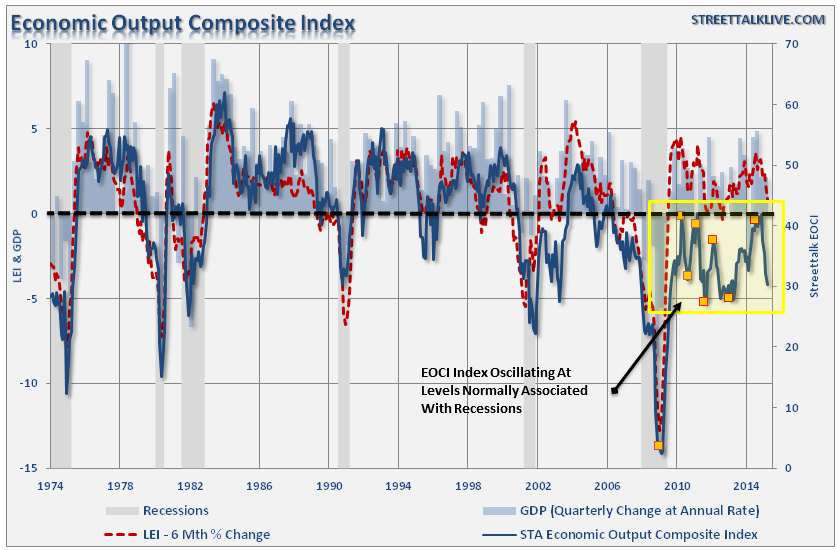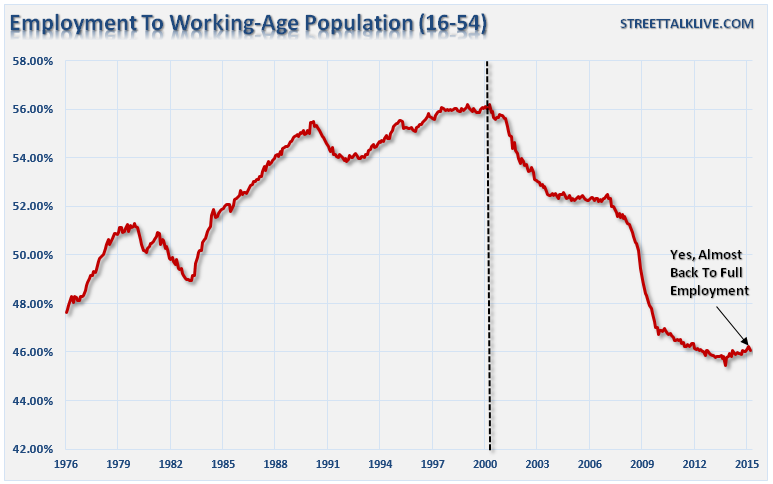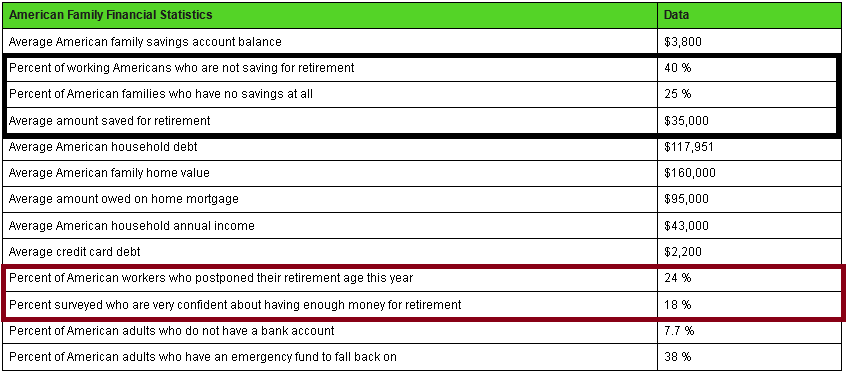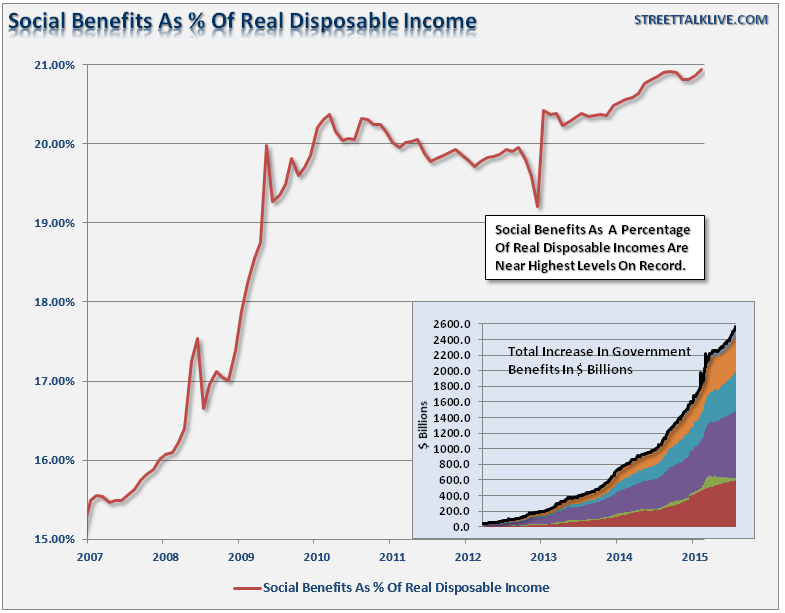I had to chuckle on Sunday as I read an article by Josh Boak's via Business Insider, "2015 Has Broken Everyone's Assumptions So Far," which stated:
"Yet all those common assumptions about how an economy thrives appear to have broken down during the first three months of 2015."
If you have been reading my blog for very long, you will already know that I have argued precisely against the common meme as espoused in Josh's article. In the post-financial crisis world:
1) Employment figures are an obfuscation caused by a structural shift in employment and a shrinkage of the active labor force.
2) Cheap gasoline does NOT power consumer spending.
3) Falling unemployment does not boost wages which there is a large available labor pool.
4) Inorganic economic growth does not lead to higher incomes
With the stock market having doubled in price from its 2009 nadir, it is certainly understandable why Josh and many others, would be lost as to the divergence between statistically driven headlines and economic realities.
But the real danger is coming from the Federal Reserve, which is considering tightening monetary policy by raising rates sometime this year. But the real question is why?
The Federal Reserve tries to control economic growth, and subsequently inflation, by tightening or loosening monetary policy. When an economy is growing too quickly, the Federal Reserve raises interest rates to slow economic growth to prevent inflationary pressures from accelerating too quickly.
However, with the economy currently growing at only slightly more than 2% annually, since the turn of the century, and inflation running well below the Fed's 2% target, what incentive is there in raising the overnight lending rate? In my opinion, none. Let me explain.
Friday's employment report, which was not surprising in its decline, is a reflection of the deterioration in the economic data over the last two-quarters. That weakness can clearly be seen in the Economic Composite Index (click here for construction), which has fallen since the end of QE3. (Gold squares show start and end of Fed's QE programs)
While it is an accurate statement that the U-3 unemployment rate, as reported by the BLS, has dropped to 5.5% as of the latest report, there is much controversy surrounding the validity of that statement. (For more on this read: What Is The Real Unemployment Rate?")
However, it is quite hard to suggest that 94.5% of the population is employed, when almost 93 million individuals are no longer counted as part of it. However, when it comes to creating economic growth, it is only full-time employment that matters. Full-time employment fosters higher income levels, promotes household formations and increased consumption. In an economy that is roughly 70% driven by consumption, the "quality" of employment is much more important than the "quantity."
Therefore, the first chart below shows the ratio of those that "usually work full time" as compared to the working age population (16-54 years of age. By looking at only the 16-54 population, we can strip out the argument that there is a wave a "retiree's" shrinking the current labor force.
(The 16-54 employment-to-population ratio declined in March from 46.22% to 46.07%. It is hard to suggest that the country is near full-employment when 53.97% of the 16-54 age group is not employed.)
What is missed by most of the economic reporters and analysts is that while jobs are created from one month to the next, the working age population is also growing. Since the official end of the recession in June of 2009, as shown in the chart below, employment has grown by a cumulative total of 10.24 million while the working age population (individuals over the age of 16) has grown by over 14.4 million.
This data suggests that the "real" economy is far from achieving actual full-employment levels that absorbs the excess "slack" in the labor force, increases wages and leads to organic economic growth. The risk that the Federal Reserve runs by potentially increasing interest rates too soon is that higher borrowing costs will likely fracture an already fragile employment market as businesses currently only hire as necessary to keep up with incremental demand created by population growth.
"Baby Boomers" Are All Retiring?
As stated, I stripped out workers in the charts above over the age of 54 to dismiss the argument of retiring "baby boomers." However, is that really the case? Is there a mass wave of individuals kicking up their heels to retire on social security and watch the sun set from their front porch? Ms. Yellen seems to think so:
"Labor force participation appears weaker than one would expect based on the aging of the population and the level of unemployment."
There have been numerous discussions about the number of "baby boomers" that are retiring in droves each day which is upending the labor force participation ratio. However, given numerous studies as of late about the state of personal finances in America today, it is hard to suggest that the "golden years" will be anything but that:
Given recent studies that suggest the median American family is heading into retirement with enough wealth for just a little more than 3 years, the outlook is not good. Of course, after two major bear markets that destroyed a large chunk of the retirement savings plans of individuals, it is not surprising that many have returned to, or continue in, the labor force to supplement retirement welfare.
As I addressed recently in "Don't Blame Baby Boomers For Not Retiring,"
"Let's start with the retirement of the boomer generation. Recent statistics shows that the average American is woefully unprepared for retirement. On average, 40% of American families are NOT saving for retirement, and of those who are, it is primarily about one year's worth of income. Furthermore, important to this particular conversation, one-fourth of those at retirement age postponed retirement with only 18% being confident of having enough saved for retirement."
"With 24% of "baby boomers" postponing retirement, due to an inability to retire, it is not surprising that the employment level of individuals OVER the age of 65 has risen sharply in recent years."
What seems to be missed by the majority of employment analysis, in my opinion, is whether the economic viability for the average American has improved? The fact the social benefits as a percentage of real disposable incomes has risen to an all-time record certainly suggests that it has not. (Important note: DPI takes into account the plunge in gasoline prices, which has boosted DPI and suppressed the increases in social benefits.)
The actual state of employment in the U.S. is likely far weaker than headline statistics currently suggest. If this is indeed the case, it creates a potential for policy mistakes that could have very negative consequences to both the economy and the financial markets.
While the Fed is "committed to policies that promote maximum employment" there is little evidence that the trillions of dollars injected into the domestic economy have had any real effect on improving employment beyond what would have been expected due to population growth.
More importantly, while the Fed has inflated asset prices to the satisfaction of Wall Street, it has done little to improve the economic prosperity for a bulk of the middle class.
While the majority of economists and analysts continue to be confused by the ongoing sluggishness in economic growth, the Fed is likely embarking on an interest rate increase cycle out of "fear" more than anything else. With the current economic cycle more than six-years into a recovery, the real risk for the Fed is getting caught in a recessionary slowdown with interest rates at zero.
Such an event would be extremely restrictive to the Fed's ability to limit the impacts of a recession and would jeopardize the fragile underpinnings of the current economy.
The economic data from March clearly suggests that the Federal Reserve should remain on hold, particularly since increasing interest rates is a policy used to "slow" an overheating economy. There is clearly no sign of that currently.






